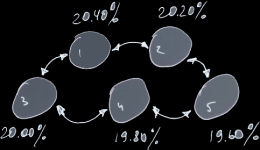
One of the key aspects of any economic or social activity is distribution—whether it involves the allocation of profits, responsibilities, or votes. In the new HIEM economic model, this issue is addressed through a mechanism of hierarchical distribution. This system not only ensures the distribution of resources but also establishes a hierarchy through multilevel voting within a group.
On a larger scale, this process transforms into a tool known as "professional voting," where each participant votes only on issues that fall within their area of expertise. In other words, each voter engages only in decisions where they possess professional knowledge.
There is also "social voting," which occurs within the social group to which the voter belongs. The same hierarchical distribution scheme applies here. Each vote is cast by individuals competent in the subject matter, and it takes place at a specific level of the hierarchy, even if that level is the only one within an egalitarian community.
The process begins at the lowest level: an issue is discussed and resolved at this stage, after which the decision is passed up to the next level. At the following level, the adopted decision goes through another round of voting, and so on until it reaches the top of the hierarchy.
For example, let’s imagine a group of six voters with an already established hierarchy consisting of three stages and two voting levels. Suppose we need to select a new leader (1) from these six participants.

The first vote takes place at level II, where participants numbered 2, 3, 4, 5, and 6 cast their votes. During this vote, they select two leaders (2 and 3) who will move on to the next stage. These two elected members now occupy leading positions at the second stage and continue participating in the next phase of the process.

After this, a vote is held at the first level, involving only the remaining three participants: numbers 1, 2, and 3. These members are now at the very top of the hierarchical structure and conduct the final vote to choose the new leader of the entire hierarchy.

The diagram shows the hierarchy of voters with their percentage of votes, where participant number 1 is the leader, with participants 2 and 3 subordinate to them. However, if two participants (for instance, 2 and 3) combine their votes, it could lead to a change in leadership (1). Voting takes place according to the "approval voting" system (Approval Voting).
In this system, each voter can vote for one or more candidates they approve of, and each voter may cast a vote for each candidate only once. A key feature of this system is that a voter can select any number of candidates, including casting a vote for themselves.
The winner is the candidate who receives the most approval votes and takes the leadership position (1). The runner-up takes the next most important position, and so on, depending on the final vote distribution.
The percentage distribution of votes is a fascinating topic, and we will discuss how it is formed in more detail later.
